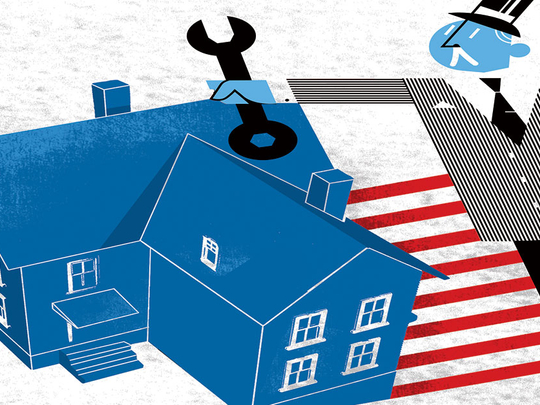
After the financial crisis of 2008, there was one thing that almost everyone agreed on. The US government-sponsored mortgage giants, Fannie Mae and Freddie Mac, had to go.
While shareholders and executives reaped the profits from Fannie and Freddie in good times, taxpayers were stuck with the bill in a crisis. President Barack Obama described their dysfunctional business model as “Heads we win, tails you lose.”
But here we are, seven years after the crisis, and nothing has changed.
Fannie Mae and Freddie Mac were meant to make it easier for Americans to buy their own homes. By buying up mortgages issued by other lenders, they enabled the lenders to make more loans.
Fannie and Freddie could then package the payments that Americans made on their home mortgages into securities to sell to investors, from big bond funds to foreign central banks. In this way, a saver in China financed the purchase of a home in Kansas.
In many ways, the system worked beautifully. But Fannie and Freddie accrued tremendous power and wealth because of the primacy of housing at the centre of the American dream, combined with the perception that these loans had the full backing of the US government.
They abused that perception. Executives paid themselves lavish salaries, and the companies, particularly Fannie, relentlessly lobbied Congress to keep their advantages and dodge regulations.
In the 2008 crisis, when it looked as if Fannie and Freddie might go bankrupt, Henry M. Paulson Jr., then the Treasury secretary, argued that their fall would cause economic catastrophe. Foreign investors, stuck with their securities, would panic, and the mortgage market would shut down.
So Fannie and Freddie were put into something called conservatorship and are now government controlled, supported by a line of credit from the Treasury.
Conservatorship was supposed to be temporary - a “time out,” according to Paulson. We were going to stabilise the companies’ finances, reduce their importance to the mortgage market, and figure out a better system.
But nothing happened. In fact, the situation has gotten even more precarious. In the years since the crisis, private lenders, for the most part, have been willing to make mortgages if they can immediately sell them to government agencies, mainly Fannie and Freddie.
In other words, without Fannie and Freddie, there wouldn’t be much of a mortgage market.
To make things worse, the government decided to “sweep” almost all the duo’s profits into its own coffers, to be used as a slush fund for general government expenses. As Treasury Secretary Jacob J. Lew said in congressional testimony this spring, “As a practical matter it’s what has helped us reduce our overall deficit.”
If there is another downturn in the real estate market and Fannie and Freddie suffer losses on their some $5 trillion (Dh18.37 trillion) in outstanding securities, taxpayers will again have to foot the bill.
Jim Parrott, a senior adviser with the National Economic Council in the Obama administration and now a fellow at the Urban Institute, wrote that the current system was “the worst of all worlds: It attracts too little private capital, provides too little mortgage credit, and still poses too much risk to the taxpayer.”
There has been one serious attempt to get rid of Fannie and Freddie, a bipartisan bill sponsored by Sens. Bob Corker and Mark Warner, that did not make it out of the Senate.
But is it really practical to kill Fannie and Freddie? We as a society want much of what they provide, which is relatively consistent access, through good times and bad, for a wide section of society, to a 30-year fixed-rate mortgage.
Critics argued that the Corker-Warner plan would essentially turn the mortgage market over to the big banks and lead to fewer loans at higher rates.
At a time of economic uncertainty, when income inequality is a major issue, it is also not a great thing for social cohesion to require those at the lower end of the income scale to start paying far higher rates for their mortgages than those at the upper end, which most analysts agree would be the case if purely private capital financed the mortgage market.
If we can’t do any better, isn’t it time to fix what we have and ease Fannie and Freddie out of conservatorship? The first step is to stop sending all their dividends to the Treasury.
That would allow them to start rebuilding capital, eventually to a level substantially higher than what they were allowed to operate with before the crisis.
Then, let’s devise a tighter regulatory structure, one that limits the businesses in which Fannie and Freddie can operate, limits the incentives of their management teams to take risk, and limits their ability to lobby.
We could cap the returns to shareholders, as utilities do.
Franklin D. Raines, Fannie’s former chief executive, suggests structuring them like mutual insurance companies, which are owned by their policyholders, who would in this case be homeowners, rather than shareholders.
A guarantee fund, modelled after the Federal Deposit Insurance Corporation, could support the companies in times of stress as the FDIC does banks. It would not be perfect.
But if the alternative is doing nothing, it’s a whole lot better than that.
— New York Times News Service












